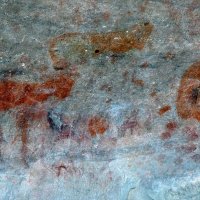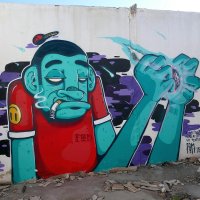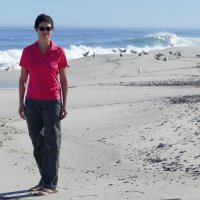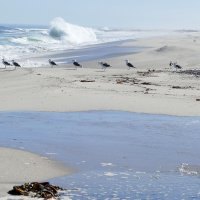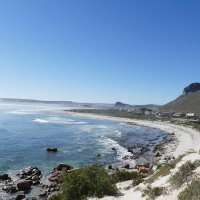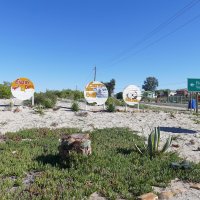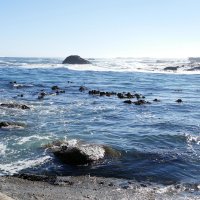
Grandiose landscapes. Peace and solitude
Our first trip to Africa together was to Namibia in 1999. For our 20th anniversary its a nice idea to visit this destination again. Besides, we want to "tick off" our last "white spots" in southern Africa, the Fish River Canyon and the west coast of South Africa.
These are the motivations for the 2019 trip from Windhoek to Cape Town. As a means of transport we chose again a Toyota Hilux with roof tent and good camping equipment, this time from the company "Bushlore". The equipment stood out positively from our previous vehicles, which were rather spartan, especially in terms of accessories (compressor, spade, Sandrail, harness).
For technical reasons we have divided the route-maps in 2 photos:
Windhoek
We fly from Frankfurt to Windhoek with South African Airways in a Boeing 340-600, which is already getting very old. For Sabine the flight is not so relaxed. Her screen is upside down. She can't lull herself to sleep with movies.
As is usually the case, the food selection on the cheap seats is very limited. At dinner, the selection is limited to beef, and at breakfast, only scrambled eggs with mushrooms are offered. The cabin crew is nevertheless very helpful and friendly.
At Windhoek airport the Bushlore company picks us up. It is 35 km to the city. The car handover/instruction is very thorough and takes 2.5 hours. We are happy when we can finally check in at the Rivendell guesthouse, where we had also stayed 20 years ago.
The reception is friendly and we get a room near the pool. Next door, a new multi-story hotel was built, which now blocks the view somewhat. There is a nice bar where we can have our afternoon tea in the form of a cold beer.
The restaurant scene in Windhoek has also changed a lot in the last 20 years. We take our cue from TripAdvisor and book our dinner at Stellenbosch Wine Bar, a good ending of the day.
Rostock Ritz Dessert Lodge
On the 20th of April we start early. First we look for the newest SPAR market in town and fill our fridge with food and drinks. The day's route takes us west over the picturesque Gamsberg Pass to our destination for the day, Rostock Ritz. The Gamsberg Pass (2247 meters) is easily recognizable as a table mountain from all directions. There, the Max Planck Institute had already established a facility for the study of celestial phenomena in 1972. Today the observatory is open for amateur astronomers. We rest and marvel at the vegetationless and bizarre rocky landscape. A farmer joins us and we get a lot of information about the area.
After exploring the Rostock-Ritz-campsite, we book a table at the associated restaurant "Dessert Lodge".We start the evening with a tasty gin and tonic. We order Springbok and Oriyx for 227 Rand per dish (well fried but a bit boringly arranged). The Fairview Chenin Blanc is an excellent match. Setting up the rooftop tent in the dark works flawlessly. The starry night is dead quiet. No noise disturbs our sleep; we only get up at 7:30 am. Personal record!
Namib-Naukluft Park
On Easter Sunday we are on our way to the big red dunes and the Sesriem Canyon. Halfway there, the obligatory stop at McGregor's Desert Bakery, Solitaire. The apple pie, which is advertised everywhere, is unfortunately sold out.
The Sesriem Campsite is just behind the park entrance. In the spacious complex with several sanitary blocks we have pitch 22, under a shady acacia tree and with electricity.
Dune 45, Sossusvlei
In the afternoon we start with the dune tours. Elim does not impress us much, Dune 45 we climb. A sweaty and partly also dizzy affair in the heat.
For the kilometer from Deadvlei to Sossusvlei the 4x4 has to be switched on. Finally real deep sand! The great plays of light and shadow around the dunes are reward for the little driving stress.
Sesriem Canyon
Before we leave the park the next day, we take a look at the Sesriem Canyon. It is about 30m deep and well worth a visit.
Koiimasis Ranch
We cross the Namib-Rand Nature Reserve, the largest private protected area in southern Africa, heading south on the D707. With the Tirasberg Mountains to the east and the dunes to the west, it is considered the most beautiful road in Namibia. In the middle of the Tiras Mountains lies our destination for the day, the Ranch Koiimasis. The ranch offers accommodation in a farm lodge with restaurant and great camping pitches with private bathroom and cooking facilities, which we opt for. We encounter the rare bat-eared foxes during the extended hike on the ranch grounds. We buy our barbecue and vegetables in the ranch store. Dassies keep us company during our barbecue. The night was fresh.
Naute Dam
At a fuel stop in Aus, we decide against the turnoff to Lüderitz and instead take the direct route to Gonndwana Roadhouse. On the long way through dry landscapes it suddenly turns green. Around the Naute Dam, an extensive area of vines, dates, prickly pears and pomegranates has sprung up. The first stop at the dam is not very inviting or spectacular, a crumbling kiosk, destroyed benches and trash.
We continue, the date palms and vines in view and finally discover the distillery of Naute crystal. We decide to have a taste. The quality and the nice conversations with the owners convince us completely. As a rarity we purchase a bottle of gin with devil's claw from the Kalahari.
Gondwana, Canyon Roadhouse
Our last stop in Namibia is the Fish River Canyon. We have chosen the Gondwana Canyon Roadhouse as our base station.
From Aus it is 200 km to Hobas; about 30 km before the town we turn right towards the canyon. We are surprised by the roadhouse. It consists of a rustic guesthouse, a restaurant with bar and pool and the campsite. For decoration, old cars and farm equipment were draped everywhere. Directly at the campsite start some interesting hiking trails. We grab a beer and a burger right away. Then we hike the surrounding area with a Klaus "shortcut". But always the goal in mind we manage to be back on time. Very relaxing walk!
Through the Whatsapp Easter greetings we learn that Gerhard and Sybille are very near to us. They are on their way back to Botswana after their Easter vacation. We arrange a spontaneous meeting. They take a short detour (about 100 km) and join us at our campsite for one day. Nice talks, nice food, a few beers by the pool and news from the Lessau family.
Fishriver Canyon
From the roadhouse we quickly reach the northern beginning of the canyon. The huge canyon of the Fish River is up to 27 km wide, 550 m deep in places and stretches over 160 km from north to south. It is considered the largest canyon in Africa and the second largest on earth. From the main viewpoint you have an impressive view down to Hells Bend. The guided tour to the bottom of the canyon takes 3 days. We had to skip that. Instead we walk to some viewing platforms and enjoy the magnificent views.
At the park exit there is a new restaurant, which unfortunately was closed, just like the adjacent campground (flooding!). Instead of lunch in the restaurant we have a cold beer at the kiosk.
Springbok
Springbok is our first destination in South Africa. As of now we have not pre-booked any places to stay.
Gerhard advises us not to take the standard route via Vioolsdrift. Instead we drive via Ais-Ais, Boplaas, Sendlingsdrift through the restricted area to the border crossing at Oranjemund. According to the guidebook the route through the restricted area is not open to the public, since a short time ago this has been changed. We are the only customers at the border crossing and the Namibian border official is very nice and relaxed. Unfortunately, he forgets to put a stamp or the correct date in our passports. Promptly we have to turn back at the South African customs. The Namibian border official has noticed his mistake in the meantime and corrects everything. The lady at the RSA border now lets us enter without any problems. The onward journey parallel to the coast through the restricted area to Port Nolloth is rather monotonous. After a fuel stop we drive east to the N7. Then again directly south to our destination of the day. Springbok, the capital of Namaqualand, lies in the middle of mighty granite hills of the Klein Koper Mountains. It is the center of the diamond industry of the coast and of copper mining in Nababeep and Okiep and the starting point of the Flower Route to the Namaqualand National Park. Meanwhile the temperature has dropped from 30 to 16 degrees. A sure sign, that we are heading south.
Cederberg Mountains - Clanwilliam Jamaka Farm
We reach our next destination, the Cederberg Mountains and the small town of Clanwilliam, after a 3 1/2 hour drive. The Cederberg Mountains are a mountain range, 250 km north of Cape Town, a well known area for hikers, climbers and mountain bikers. We spend the night at Jamaka Farm, run by a German-born family, which offers delicious fruit and rooibos tea, in their farm stall. Now, in the low season, the campsite is not well booked. We are spoiled for choice and decide, also because of an sudden invasion of finger-long caterpillars, for site 12b, right next to the shower. The surroundings are fantastic. The Rondegat River flows through the site, citrus and mango trees everywhere. There are also many hiking trails leading through the "Cederberg Wilderness Area", since 2004 UNESCO World Heritage Site. The Cape Leopard Trust, which works to protect the Cape Mountain Leopard, also operates here. There was time for an extended hike to Nieuwoudt Pass in the early morning.
Citrusdal
We had actually planned a circuit via Citrusdal to Sanddrift to stay at the Holiday Resort with many amenities. There is a lot of traffic and the town is full of people. It's payday and everyone is out shopping. We check the travel time to our planned destination. We would have to plan for over three hours - clearly too much driving in this beautiful weather. Besides, we are hungry. The choice of the restaurant is responsible for the further driving route. On the Piekonierskloof we find the appealing restaurant Hebron with a well-stocked wine bar. Strengthened and with a few bottles in our luggage we start towards Elands Bay.
Vensterklip Guest Farm
The mediocre rating of the Eland's Bay campground has us looking for alternatives. We book ourselves into Vernsterklip Guest Farm, seven kilometers off the coast. According to the website, the accommodation is promising. Campsite, shower and the proximity to the lagoon Verlorenvlei (Birders Paradise) are successful. Unfortunately, the restaurant and bar are closed. Fortunately, there is still cheese in the cooler and a Chenin Blanc from Piekenierskloof.
Eland's Bay
The cozy fishing village of Eland's Bay is popular with surfers and birdwatchers alike. For culture lovers there are also rock paintings to discover in the Eland's Bay caves. On the way to the rock paintings, some artists have left impressive graffiti on the walls of dilapidated buildings. In the rock caves young people stay overnight with rubber dinghy and surfboard.
We explore the beach, climb to the caves with the paintings and, as always, check out the gastronomy. The weather, the place and the atmosphere invite us to slow down. So it's fitting that we have some delicious craft beer from the Cederberg Mountains for lunch.
Fossil Park
On the way towards Paternoster, road signs draw attention to the West Coast Fossil Park Heritage Site. We check the internet and learn that there is a new visitor center here. The visitor center with museum and many excavation sites is located in a former phosphor mine. During mining, the operators discovered countless bones of prehistoric marine and land animals in a dried-up riverbed. After the mine was closed in 1993, the site was opened for research purposes. The guided tour and lectures are quite entertaining and worth a visit.
Paternoster
Paternoster had been on our bucket list for quite some time. This bustling seaside town with its white houses is the weekend destination for busy Capetonians. Restaurants and cafes line the streets leading to the beach, and accommodations are available in all categories. It's Sunday - the town and beach are accordingly crowded.
The campground is located in the Cape Columbine Nature Reserve below the lighthouse and about 15 minutes from the center. At the park entrance we pay entrance fee for the park and fee for camping. The park attendant is extremely friendly and somehow surprised that we arrive on Sunday afternoon.
The campground is well attended; many families are packing their cars for returning home.
We drive back to town to enjoy the last rays of sun from the terrace of a restaurant. On the way we take some impressions and views from the lighthouse area.
Shortly before nightfall we start our way back. In the meantime it is quite fresh and the wind blows the waves onto the beach. The campground is yawningly empty. All cars and people have disappeared. We are alone. It is pitch dark, very foggy and freezing cold. For the first time on this trip we feel a bit insecure. In our minds we already see ourselves lying robbed on the beach. We find a sheltered spot next to a boulder. The regular warning sounds from the nearby lighthouse add to the spooky atmosphere. All in all, the last night in the roof tent is better than expected. We leave early and drive directly to the golf course in Langebaan, where a rich South African breakfast awaits us.
Langebaan
During our last visit to Cape Town Langebaan was the northernmost destination we had approached from the south. We stayed at the Longacre Olive & Vineyard Estate. We liked it so much that we decided to stay there again. The owner, Rodney Steinhofel, has realized his retirement dreams, growing wine and olives and breeds ostriches. Of course we buy pickled olives and olive oil from Rodney. His wine we drink directly on site.
Langebaan is a quiet resort that only awakens from its sleep at South African vacation times. Compared to our last stay, we noticed an increasing number of weekenders arriving from Cape Town. The main attraction is the Weastcoast National Park, which begins right on the outskirts of town. The town also boasts a very well-maintained Gary Player golf course, with which we still had a score to settle. From 10 o'clock the wind freshens up and increases to gale force until the afternoon. Last time we had played in the afternoon, with disastrous results. The revenge succeeded, because this time we already finished playing around 11 o'clock, with presentable results and without frustration.
We had our dinner after a walk on the beach in the Beach Restaurant Kokomo ("get here fast, then take it slow"). Also highly recommended.
Cape Town
For the way to Cape Town we choose the route through the Westcoast National Park. The park is a bird sanctuary with 256 bird species, but they are more likely to be seen and heard in the morning. While driving through we only spotted one turtle on the roadside.
In Cape Town we spend two wonderful days with our friends Gaby and Alan before we start our journey home. On the photo Sabine and Gaby enjoy the view from Table Mountain towards the city.



